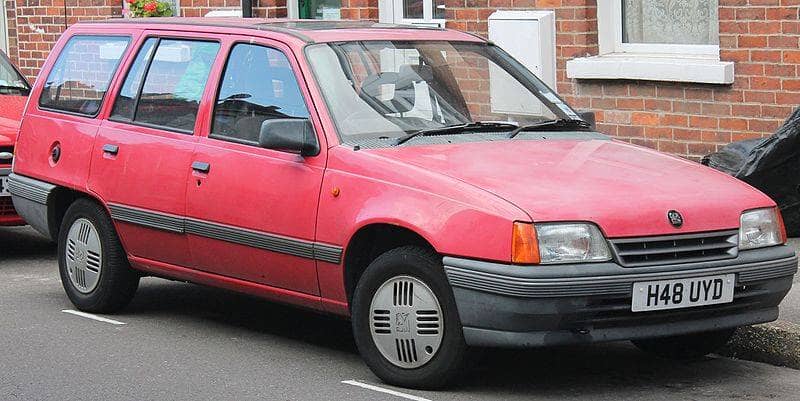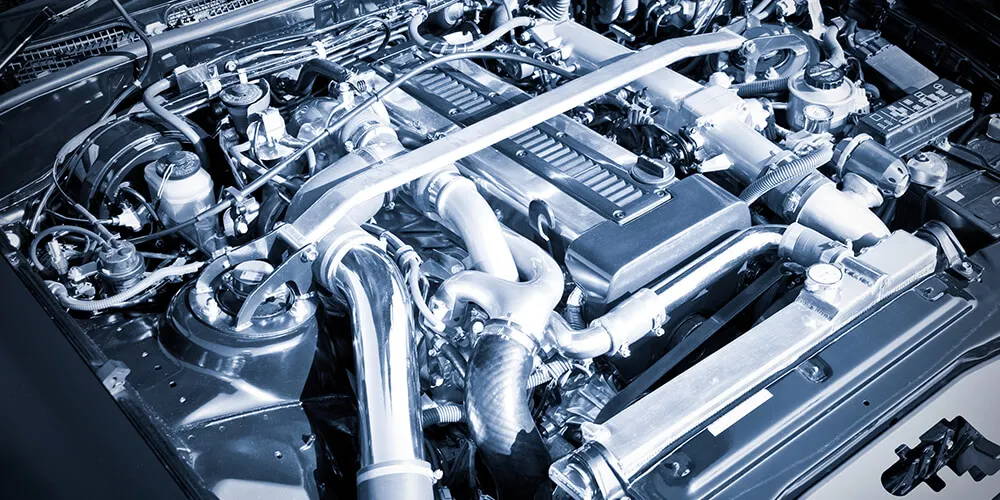We all notice a gleaming paint job or a set of pristine wheels, but well-maintained black plastic trim plays a vital role in maintaining the overall visual impact of your ride. If your car is a few years old and looking a little less fresh than it used to, take a moment to go check out the plastic trim…
Chances are, what used to be a deep black color has started to fade to gray. Sadly, not even the most carefully maintained exterior will look anything other than second-rate unless that trim is in top condition. Deep blacks look smooth and clean, and will provide the contrast against body panels that makes your paintwork pop.
So, today, we’re going to show you exactly what you need to do to give that trim a makeover and restore the dynamism to your ride’s exterior!
The methods in this article will work on both interior and exterior plastic.
★★★★★ "I used it on a '97 Honda van and the trim went back twenty-plus years. I was blown away... two coats and it was like new." - Keith V.
"My bumpers was fading. I’ve used many products, but they just painted them black. I used this product and they look like when I first bought my Jeep. This product is the BOMB!" - Lindellar
"Best product I've used. (I have used a lot of protectant products in the past). Black plastic and rubber is no longer a issue. Long lasting and looks great." - PJM
"Used on both interior and exterior plastic parts. I am very pleased with the results. The dashboard is very nice looking and does not attract dust. Bleached looking exterior parts look like original." - Jack S
Why Does Black Plastic Fade Over Time And Turn White?
Faded plastic bumper. A common woe of old car owners.
Plastic naturally contains a lot of oils. Over time, those oils near the surface degrade and dry out, leading to discoloration. Unlike paintwork, plastic trim pieces don’t have a protective clear coat. So, without this layer of defense, it will always be more susceptible to damage from the elements.
Sunlight is the main culprit. UV rays dehydrate the plastic and degrade it on a molecular level. Then there are contaminates from the road, which will only speed up the degradation process. So, depending on where you live, where you store your car, and the road conditions, the plastics can be one of your car’s first areas to need an overhaul.
Method #1: Plastic Restore (Recommended)
Here at Torque Detail, we’ve tried almost every product and DIY hack to find a real solution to the problem of faded black plastic panels. When nothing worked how we hoped, we decided it was time to create the ultimate product to fix faded plastic trim quickly, easily, and with industry-leading effectiveness. Now, we’re proud to finally be able to offer Torque Detail Plastic Restore!
What You’ll Need
If your car is already clean, you can get started immediately. However, if it needs a wash, we highly recommend going through our exterior detailing guide for a complete wash before beginning the restoration. A thorough clean prevents any damaging contaminants from being worked into the plastic’s surface, and guarantees the cleanest and most professional-looking results.
How To Use
Using Torque Detail Plastic Restore couldn’t be simpler. We’ve designed the compound to do the heavy lifting for you!
Step 1) Apply the Plastic Restore (black trim restorer product)
Give the plastic trim a generous spray with Torque Detail Plastic Restore, making sure to cover every area. Don’t worry if there’s overspray onto the paint. Unlike some other plastic restorers, we’ve designed this product to be safe on paintwork.
Let the spray sit for at least thirty seconds, although sixty seconds is ideal. This gives the restorer time to sink deep into the plastic and change its molecular structure. We know it’s tempting to wipe it away immediately to see the changes in all their glory! But trust us, this is the part where the Plastic Restore does the real work, so it’s worth giving it time.
Step 2) Restore
Take your clean microfiber towel and wipe away the excess liquid from the surface. Any pools of liquid will attract dirt, so be sure to dry all the panels’ little creases and valleys.
Then, stand back and take a first look at the changes! We can guarantee that even one coat will make a huge difference!
Follow-up coats
Voila! Your plastic is looking good as new and is now UV protected.
If your plastics just needed a quick boost back to factory-fresh, one coat may be enough. However, many vehicles will benefit from at least two applications. It’s not uncommon to see continued improvements from up to four coats on cars a decade old!
You can rest assured that our full 100% money-back guarantee backs every bottle we make. If you aren’t satisfied with the results, you can request a full refund - no questions asked.
Method #2: Heat Gun
Instead of adding restorative oils, the heat gun method draws out the oil already embedded deep in the plastic and brings it to the surface to restore its appearance.
What You’ll Need
- Heat gun (we do not advise using a high-powered heat gun)
Step 1)
First of all, park your car in the sun to get those plastics as hot as possible. It’s true that UV rays are a big part of the problem, but one extra hour of sun isn’t the end of the world. Starting from a higher temperature will make the whole job far, far quicker.
Next, take your heat gun and set it to medium-low. The aim is to heat the plastic, not melt it! Every gun is different, so take some time to find out which settings work for you.
Step 2)
Slowly work the heat over the surface area you want to restore. The key here is to be methodical and heat a small area evenly before moving on to the next. Slowly, as the plastic heats up, you should see its natural deep black color returning. It might seem hard to believe that this really works, but all you’re seeing is the oils being drawn to the surface.
This method can produce great results, but there are some factors to bear in mind…
Firstly, this is not a permanent fix, despite what some people claim. The oils will gradually start to dry and degrade again, so you will have to repeat the process. However, you can’t repeat it forever, because ultimately, only a limited amount of oil is stored in the plastic.
Secondly, don’t expect results in seconds. Using the heat gun is a time-consuming process, so ensure you have an afternoon free to complete the job!
Thirdly, heat and bodywork don’t always mix. When working on smaller plastic panels, it can be tricky to direct all the heat onto the plastic and away from paintwork. Excessive heat can cause the paint to bubble. So, if you’re trying the heat gun method, please take care!
Method #3: Repaint It
Instead of restoring the plastic itself, an alternative is to simply paint over it. After all, paint, unlike plastic, will not fade for a very long time.
Sounds pretty good! But before you run to the store to pick up a few cans of Rust-Oleum, there are a few things to take into account…
Most people want a simple flat black on their trim. However, automakers produce black exterior trim in a never-ending array of finishes and subtly different shades of dark gray, so finding the right match can be time-consuming and expensive. The last thing we want is panels that almost match. You can guarantee that that tiny difference will stare you in the face every time you look at your ride!
Both Rust-Oleum and Duplicolor make spray paints that are suitable for car trim. They offer slightly different colors, and the time required to apply them successfully is dramatically different. If you’re thinking of going down the paint route, take a closer look at each brand to decide which one better fits your needs.
Different Plastic Trim Paints:
- Typical spray paint / rustoleum: A quick and cheap option chosen by many. Most go with a flat black spray can that’s UV-resistant (offers protection from direct sunlight).
- Bumper / trim paint: Easiest to use. Adheres the best even without any sort of primer. Works on plastic bumpers or plastic trim.
- Trim dye: The product we’d recommend for restoring rubber trim. It paints rather than sprays on.
- Plastidip: Not as durable as other paint options but this is intentional. It peels off easily so you can easily repaint your bumper / trim. Rubberized feel. Matte color. Does not provide shine if that’s what you’re looking for.
-
Truck Bedliner / raptor coating: Very popular in the truck / off-road world. Most durable option. Matte color. Has a rough, textured surface. Please do a small test on a separate piece of plastic to make sure you'll be satisfied with the results. Once it's applied, it'll be very hard to get off.
What You’ll Need
- Torque Detail Decon Wash
- Adhesion promoter primer spray (recommended, but may not be needed depending on your paint and the type of plastic you’re painting)
- Spray trim paint - or whichever paint option you go with
- Clear coat spray (ONLY if you’re going for a glossy finish)
- Wax and grease remover
- Tack cloth
Step 1) Remove the trim pieces from the vehicle
This step is optional, but will make your job a lot easier.
Don’t be that guy who thought he could get away with just being careful with the masking tape! If you’re here reading this article, it’s safe to assume that you take pride in your ride. Spend the extra time to take the panels off the car and get the job done right the first time.
Step 2)
Make sure the surface is clean! Paint needs an absolutely spotless surface. For the best results, go for a thorough decontamination with the Torque Detail Full Decon Kit, dry the panel, apply wax and grease remover, let it evaporate, and then finish off the job with a tack cloth.
Step 3)
Once the surface is clean and dry, it’s time to start spraying. Start with the adhesion promoter (if your paint or type of plastic you’re painting calls for it), followed by the paint, and finally, the clear coat. It sounds tedious, but be sure to follow all the instructions on each product’s label. Different brands work in different ways, and getting the number of coats or curing times wrong can easily lead to a cheap-looking finish.
Household Methods: Effective Or Failure?
If you’re someone who likes to improvise, there are several household remedies that might interest you. We’ve taken a closer look at these to help you decide if they’re a workable alternative.
Household Method 1) Paint thinner
Considering what paint thinner is, the results can be surprisingly good! If surfaces have already been treated with low-quality or non-purpose-specific polish or colorant like tire blackener, paint thinner can be somewhat effective. It essentially strips away the old and crusty polish to leave a clean surface underneath. It won’t restore the color of the plastic itself, but it will at least get rid of any gunk that’s been applied on top of it. However, we can’t guarantee how safe it is for your plastics. Paint thinner is strong stuff, so proceed at your own risk!
Household Method 2) Peanut butter
Now this one is interesting! Peanut butter on your car?? Well, it actually works! Because peanut butter is high in fats, it will act similarly to Torque Detail Plastic Restore in restoring oils to the plastic’s surface. You can apply smooth peanut butter like a polish, applying it and then wiping it away with clean cloths. After testing, we can’t say it’s 100% black, but for something that you usually spread on toast, it’s pretty good!
Sounds a bit too good to be true, right? Well, perhaps unsurprisingly, it is.
The first downside is that the oils in peanut butter are different from the oils in your plastics, so it won’t truly restore them on a molecular level. Secondly, it’s just messy to apply! And finally, there’s the smell. maybe we’re just fussy, but we don’t enjoy driving a car that smells like a sandwich bar! The smell of peanuts follows you everywhere!
How To Protect Your Black Plastic From UV Rays Using Ceramic Spray
Okay, so we know our options for restoring our black plastic trim to its former glory. But what about keeping it that way? Ultimately, plastic will always be vulnerable to UV rays and contaminates, so we need something to defend against this damage.
A finishing product purpose-built to beat the elements is Torque Detail Ceramic Spray. It builds an invisible and super durable ceramic layer on top of your car’s finish. Not only does this give it an ultra-premium shine that lasts for up to 12 months, but it also forms a barrier against the road contaminants and UV rays that cause plastics to fade. Designed to be easily applied at home, it takes a matter of minutes to give your ride the ultimate ceramic protection when you choose Torque Detail!
If you’re serious about getting (and keeping) that top-quality finish year after year, pick up Ceramic Spray today. And remember, we put our 100% money-back guarantee behind every product we make!
Final Notes
Taking your faded black trim back from zero to hero is guaranteed to maximize the visual impact of your ride. If you haven’t tried it yet, you’ll be stunned at what a difference it can make! Your plastic is now back to black.
When it comes to choosing the right method, we hope you’re now equipped to select the route that’s right for you. All of us are here for one reason: because we’re passionate about keeping our rides looking phenomenal. So, choose your weapon and soon, there’s no doubt you’ll have your car looking its best ever!
★★★★★ "I used it on a '97 Honda van and the trim went back twenty-plus years. I was blown away... two coats and it was like new." - Keith V.
"My bumpers was fading. I’ve used many products, but they just painted them black. I used this product and they look like when I first bought my Jeep. This product is the BOMB!" - Lindellar
"Best product I've used. (I have used a lot of protectant products in the past). Black plastic and rubber is no longer a issue. Long lasting and looks great." - PJM
"Used on both interior and exterior plastic parts. I am very pleased with the results. The dashboard is very nice looking and does not attract dust. Bleached looking exterior parts look like original." - Jack S







